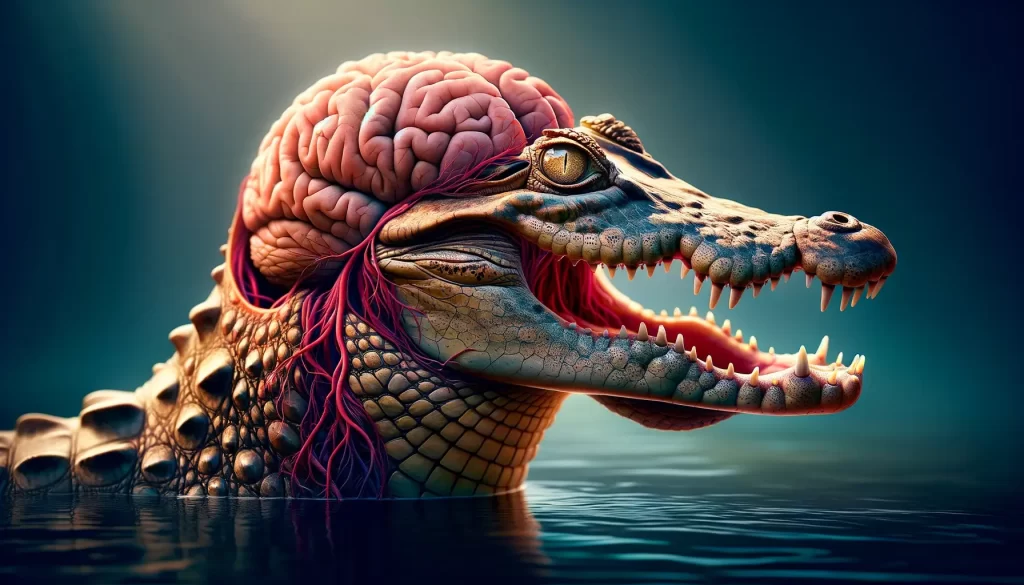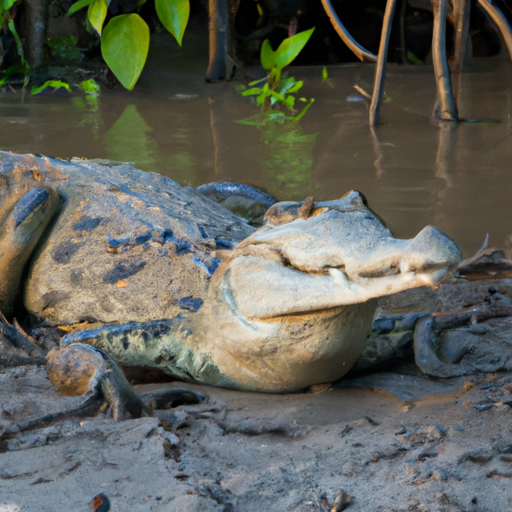
Imagine if you could peer into the mind of a crocodile – the ancient, powerful reptile that has fascinated humans for centuries.
Have you ever wondered just how big a crocodile’s brain is, and how it compares to our own?
Delving into the depths of the animal kingdom, this article explores the fascinating world of crocodile brain size and its implications on their behavior and intelligence.
Prepare to be amazed as we unveil the secrets hidden within the mind of these ancient predators.
Brain size in crocodiles
Crocodiles are famous for their impressive size and strength, but have you ever wondered how their brains measure up?
In this article, we will delve into the fascinating world of crocodile brains, exploring their size, structure, and the potential impact on their behavior and cognitive abilities.
By understanding the brain size of crocodiles and comparing it to other animals, we can gain valuable insights into the evolutionary significance and unique characteristics of these ancient reptiles.
Comparing crocodile brains to other animals
When it comes to brain size, crocodiles hold their own against many other animals. While they may not have the largest brains among all species, crocodile brains are relatively large compared to their body size.
For example, the average crocodile brain is about the size of a walnut, weighing around 8-12 grams. In comparison to their massive bodies, this is quite impressive.
Crocodile brains can be compared to those of other reptiles, such as turtles and lizards. The size of a crocodile’s brain is considerably larger than that of a turtle or lizard, showcasing their higher cognitive capabilities.
However, in terms of brain size, crocodiles fall short when compared to mammals, including humans.
This difference in brain size highlights the variation in cognitive abilities and evolutionary adaptations across different animal species.
Factors affecting brain size
Several factors influence the brain size of crocodiles. One significant factor is the overall body size of the crocodile.
As body size increases, there is typically a corresponding increase in brain size. This phenomenon, known as allometric scaling, can be observed across a wide range of animal species.
In crocodiles, larger species tend to have larger brains, although this is not always the case.
Another factor that can affect brain size is the lifestyle and ecological niche of the crocodile. Different species may have specialized behaviors and cognitive abilities, which may be reflected in variations in brain size. For instance, a crocodile that relies heavily on problem-solving skills and complex social behavior may have a larger brain compared to a species that exhibits more instinctive behaviors.
Measuring crocodile brain size
To accurately measure the brain size of crocodiles, researchers employ a combination of external and internal measurements. External measurements involve examining the size and dimensions of the skull, while internal measurements focus on dissecting the brain and assessing its different regions.
External measurements mainly revolve around the skull length and width, as well as the length and width of specific brain regions, such as the forebrain, midbrain, and hindbrain. These measurements provide valuable information about the overall size and structure of the crocodile brain.
Internal measurements, on the other hand, require the careful dissection of the brain to determine the size of specific brain regions and calculate the total brain volume. This method provides a more detailed understanding of the internal structures and organization of the crocodile brain.
Comparing brain size between different species of crocodiles allows researchers to explore the evolutionary adaptations and ecological niches of these magnificent creatures.
Crocodile brain structure
The brain structure of a crocodile is divided into three main regions: the forebrain, midbrain, and hindbrain. Each region plays a crucial role in different cognitive functions and behaviors.
The forebrain is responsible for higher-order cognitive functions such as problem-solving, learning, and memory. It contains the cerebrum, which is highly developed in crocodiles. The cerebrum is further divided into different lobes, each associated with specific cognitive tasks.
The midbrain functions as a relay center, transmitting sensory information from the body to the forebrain. It also regulates basic motor functions and helps coordinate movement.
The hindbrain controls involuntary actions such as breathing and heart rate. It also plays a vital role in maintaining balance and coordination.
Evolutionary significance of crocodile brain size
The relatively large brain size of crocodiles has evolutionary advantages that contribute to their survival and hunting abilities. With a larger brain, crocodiles are equipped with enhanced problem-solving skills, allowing them to tackle complex tasks in their environment.
Crocodiles are highly adaptive creatures, capable of learning from their surroundings and adjusting their behaviors accordingly. Their larger brains facilitate this ability to learn and adapt to changing circumstances, giving them a significant advantage in their natural habitats.
Moreover, crocodiles are known for their remarkable hunting abilities. Their larger brains aid in strategizing and executing successful hunting techniques. With a more developed forebrain, crocodiles can exhibit advanced hunting behaviors, such as patience, stealth, and precision.
Comparing brain size between crocodile species
When comparing brain size between different species of crocodiles, some interesting variations emerge. For example, the Cuban crocodile (Crocodylus rhombifer) has a relatively smaller brain compared to the Nile crocodile (Crocodylus niloticus). This difference in brain size could be attributed to variations in ecological niche and behavior between the two species.
Similarly, the saltwater crocodile (Crocodylus porosus) and the American alligator (Alligator mississippiensis) exhibit differences in brain size. The saltwater crocodile, being the largest living reptile, has a more significant brain compared to the American alligator, contributing to its impressive cognitive abilities and survival strategies.
Influence of body size on crocodile brain size
Allometric scaling, the relationship between body size and brain size, plays a significant role in determining crocodile brain size. As crocodile species vary in body size, their brain sizes follow suit.
Larger crocodile species, such as the saltwater crocodile and Nile crocodile, tend to have larger brains. This increase in brain size allows for better cognitive abilities and more complex behaviors. However, it is important to note that brain size is not the sole determinant of intelligence or behavior. Other factors, such as brain structure and connectivity, also contribute to an animal’s cognitive abilities.
The implications of body size on behavior and cognition highlight the interplay between physical characteristics and neurological development in crocodile species.
Cognitive abilities in crocodiles
While crocodiles are often associated with primitive instincts, they possess a range of cognitive abilities that are essential for their survival and social interactions. Crocodiles have shown impressive problem-solving skills, including the ability to overcome obstacles and manipulate their environment to their advantage.
Social behavior is another significant aspect of crocodile cognition. Although traditionally seen as solitary creatures, recent research has shown that crocodiles can engage in complex social interactions. By recognizing and remembering individuals within their social groups, crocodiles demonstrate a level of social cognition that was once thought to be exclusive to mammals.
Crocodiles also possess long-term memory, allowing them to remember locations of important resources, such as nesting sites and food sources, even after long periods of time. This cognitive ability aids in their survival and successful navigation within their habitats.
Brain size and behavior in crocodiles
The brain size of crocodiles has a direct impact on their behavior and hunting strategies. Their larger brains give them the ability to exhibit complex hunting behaviors that require patience, planning, and execution.
Crocodiles are known for their stealthy and patient hunting tactics. With a larger brain and a more developed forebrain, they can plan their attacks with precision, waiting for the perfect moment to strike. This strategy allows them to conserve energy and maximize their chances of successful prey capture.
Furthermore, the larger brain of crocodiles contributes to their overall learning and adaptation capabilities. By learning from past experiences and adjusting their behaviors accordingly, crocodiles improve their chances of survival and successful reproduction.
Crocodiles also exhibit remarkable parental care, which involves protecting and nurturing their offspring. The larger brain of crocodiles may play a role in their ability to recognize and remember their young, allowing them to provide the necessary care and protection during the early stages of their offspring’s development.
Threats to crocodile brain health
Crocodile brain health can be significantly impacted by various threats in their environment. Pollution and contaminants, such as heavy metals and pesticides, can accumulate in their bodies and negatively affect their brain function. These pollutants can lead to cognitive impairments and disrupt crucial cognitive processes.
Loss of habitat and food sources can also have detrimental effects on crocodile brain health. Habitat destruction and fragmentation limit the resources available to crocodiles, affecting their overall nutrition and ultimately impacting brain development and function.
Lastly, climate change poses a significant threat to crocodile populations. Rising temperatures, changes in rainfall patterns, and sea-level rise can disrupt the delicate balance of ecosystems, impacting the availability of suitable habitats and altering the behavior and cognitive processes of crocodiles.
Research methods for studying crocodile brain
Studying crocodile brains requires specialized research methods that provide insights into their structure and cognitive abilities.
Neuroimaging techniques, such as magnetic resonance imaging (MRI), can provide detailed images of the brain’s internal structures, allowing researchers to analyze and compare different brain regions.
Behavioral observations in natural or controlled settings provide valuable information about crocodile behaviors and cognitive abilities. Researchers can observe and record hunting strategies, problem-solving skills, and social interactions to gain a deeper understanding of how crocodile brains contribute to these behaviors.
Comparative studies with other reptiles and mammals can also shed light on the unique characteristics of crocodile brains. By comparing brain structures, cognitive abilities, and ecological behaviors across different species, researchers can unravel the evolutionary adaptations and variations in brain size among reptilian and mammalian lineages.
Final Thoughts
In conclusion, crocodiles with their unique brain size play a fascinating role in the animal kingdom.
Their relatively large brains compared to their body size enable them to exhibit complex cognitive abilities and behaviors.
Understanding the intricacies of the crocodile brain provides insights into evolutionary adaptations, hunting strategies, and cognitive capabilities.
By studying crocodile brains, we can gain a deeper understanding of the correlation between brain size and behavior, as well as the potential impact of threats such as pollution, habitat loss, and climate change on their cognitive health.



